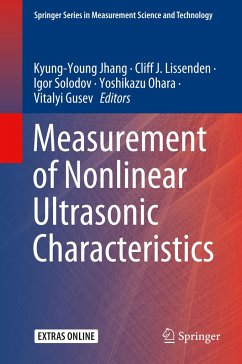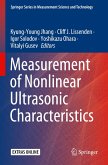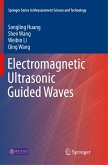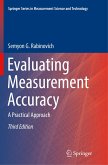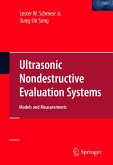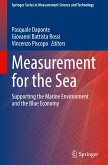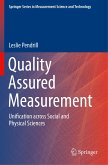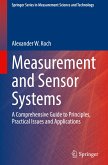Measurement of Nonlinear Ultrasonic Characteristics
Herausgegeben:Jhang, Kyung-Young; Lissenden, Cliff J.; Solodov, Igor; Ohara, Yoshikazu; Gusev, Vitalyi
Measurement of Nonlinear Ultrasonic Characteristics
Herausgegeben:Jhang, Kyung-Young; Lissenden, Cliff J.; Solodov, Igor; Ohara, Yoshikazu; Gusev, Vitalyi
- Gebundenes Buch
- Merkliste
- Auf die Merkliste
- Bewerten Bewerten
- Teilen
- Produkt teilen
- Produkterinnerung
- Produkterinnerung
Conventional ultrasonic methods based on ultrasonic characteristics in the linear elastic region are mainly sensitive to mature defects but are much less responsive to micro-damage or incipient material degradation. Recently, nonlinear ultrasonic characteristics beyond the linear ultrasonic amplitude range have been studied as a method for overcoming this limitation, and hence, many researchers are engaged in theoretical, experimental, and various application studies. However, the nonlinear ultrasonic characteristics are quite exacting compared to the linear phenomena so that they require vast…mehr
Andere Kunden interessierten sich auch für
![Measurement of Nonlinear Ultrasonic Characteristics Measurement of Nonlinear Ultrasonic Characteristics]() Measurement of Nonlinear Ultrasonic Characteristics134,99 €
Measurement of Nonlinear Ultrasonic Characteristics134,99 €![Electromagnetic Ultrasonic Guided Waves Electromagnetic Ultrasonic Guided Waves]() Songling HuangElectromagnetic Ultrasonic Guided Waves112,99 €
Songling HuangElectromagnetic Ultrasonic Guided Waves112,99 €![Evaluating Measurement Accuracy Evaluating Measurement Accuracy]() Semyon G RabinovichEvaluating Measurement Accuracy164,99 €
Semyon G RabinovichEvaluating Measurement Accuracy164,99 €![Ultrasonic Nondestructive Evaluation Systems Ultrasonic Nondestructive Evaluation Systems]() Lester W. Schmerr Jr.Ultrasonic Nondestructive Evaluation Systems164,99 €
Lester W. Schmerr Jr.Ultrasonic Nondestructive Evaluation Systems164,99 €![Measurement for the Sea Measurement for the Sea]() Measurement for the Sea97,99 €
Measurement for the Sea97,99 €![Quality Assured Measurement Quality Assured Measurement]() Leslie PendrillQuality Assured Measurement104,99 €
Leslie PendrillQuality Assured Measurement104,99 €![Measurement and Sensor Systems Measurement and Sensor Systems]() Alexander W. KochMeasurement and Sensor Systems119,99 €
Alexander W. KochMeasurement and Sensor Systems119,99 €-
-
-
Conventional ultrasonic methods based on ultrasonic characteristics in the linear elastic region are mainly sensitive to mature defects but are much less responsive to micro-damage or incipient material degradation. Recently, nonlinear ultrasonic characteristics beyond the linear ultrasonic amplitude range have been studied as a method for overcoming this limitation, and hence, many researchers are engaged in theoretical, experimental, and various application studies. However, the nonlinear ultrasonic characteristics are quite exacting compared to the linear phenomena so that they require vast experience and high proficiency in order to obtain proper experimental data. Actually, many researchers, especially beginners including graduate students, have difficulty in reliably measuring nonlinear ultrasonic characteristics. This book provides key technological know-how from experts with years of experience in this field, whichwill help researchers and engineers to obtain a clear understanding and high quality data in the nonlinear ultrasonic experiments and applications.
Produktdetails
- Produktdetails
- Springer Series in Measurement Science and Technology
- Verlag: Springer / Springer Nature Singapore / Springer, Berlin
- Artikelnr. des Verlages: 978-981-15-1460-9
- 1st edition 2020
- Seitenzahl: 300
- Erscheinungstermin: 30. Januar 2020
- Englisch
- Abmessung: 241mm x 160mm x 22mm
- Gewicht: 564g
- ISBN-13: 9789811514609
- ISBN-10: 9811514607
- Artikelnr.: 57893084
- Herstellerkennzeichnung Die Herstellerinformationen sind derzeit nicht verfügbar.
- Springer Series in Measurement Science and Technology
- Verlag: Springer / Springer Nature Singapore / Springer, Berlin
- Artikelnr. des Verlages: 978-981-15-1460-9
- 1st edition 2020
- Seitenzahl: 300
- Erscheinungstermin: 30. Januar 2020
- Englisch
- Abmessung: 241mm x 160mm x 22mm
- Gewicht: 564g
- ISBN-13: 9789811514609
- ISBN-10: 9811514607
- Artikelnr.: 57893084
- Herstellerkennzeichnung Die Herstellerinformationen sind derzeit nicht verfügbar.
Kyung-Young Jhang received his PhD from Tokyo Institute of Technology, Japan in 1991. He is currently a Professor and the Chair of Mechanical Engineering at Hanyang University. His research focuses on the area of linear & nonlinear ultrasonics for NDT&E, laser ultrasonics and laser-material intraction, ultrasonic and optical measurements and signal & image processing. He was Vice-president of Korean Society for NDT and Editor-in-Chief of Journal of the Korean Society for NDT (2012-2017).
Preface.- Chapter 1. Overviews: Nonlinear Ultrasonic Characteristics and Measurands.- Chapter 2. Elastic Nonlinearity induced Nonlinear Ultrasonic Characteristics.- 2.1 Higher Harmonics (HH) Generation,-2.2 Nonlinear Ultrasonic Parameters.- 2.2.1 Absolute Nonlinear Ultrasonic Parameter.- 2.2.2 Relative Nonlinear Ultrasonic Parameter.- 2.3 Measurement of Nonlinear Ultrasonic Parameter.- 2.3.1 Capacitive Detection and Laser-interferometric Detection.- 2.3.2 Piezo-electric Detection.- 2.3.3 Control of Propagation Distance and Control of Incident Wave Power.- 2.3.4 Phase Inversion Technique.- 2.4 Factors Affecting to Measurement Reliability.- 2.4.1 Measurement System: Transducer, Input Power, Contact Pressure, Electronic Equipment.- 2.4.2 Digital Signal Processings: Bandwidth of Incident Wave, Time Resolution, Amplitude Resolution.- 2.5 Applications to Assessment of Material Damage.- 2.5.1 Fatigue Damage.- 2.5.2 Plastic Deformation.- 2.5.3 Thermal Aging.- References.- Chapter 3. Nonlinear Acoustic Wave Interactions with Contact Interfaces: Methodologies and Applications.- 3.1. Nonlinear Reflection Approach to Interface Nonlinearity.- 3.1.1 Nonlinear acoustic reflection at an ideally bonded interface.- 3.2.1 Application of Reflection Concept to Nonlinear Interface Wave Propagation.- 3.3.1 Second Harmonic Generation of Interface Acoustic Waves.- 3.2. Acoustic Nonlinearity of a Non-Bonded Interface.- 3.2.1 Phenomenology of Contact Acoustic Nonlinearity (CAN).- 3.2.2 Higher Harmonics (HH) Generation at Contact Interfaces.- 3.2.3 Nonlinear Acoustic Reflection by Fractured Defects.- 3.2.4 Acoustic Rectification and Nonlinear Polarization Effects via CAN.- 3.3. Non-Classical Nonlinear Effects in Resonant Contact Inclusions.- 3.3.1 Concept of Local Defect Resonance.- 3.3.2 Sub- and Super-harmonic Resonances.- 3.3.3 Nonlinear Parametric Instability Effects.- 3.4. Applications for NonlinearImaging of Defects.- 3.4.1 Nonlinear Scanning Laser Vibrometry.- 3.4.2 Nonlinear Air-Coupled Emission (NACE).- 3.4.3 Case Studies of Nonlinear Imaging of Defects.- References.- Chapter 4. Nonlinear Ultrasonic Phased Array for Measurement of Closed-Crack Depth.- 4.1. Introduction.- 4.2. Harmonics.- 4.2.1. Principles.- 4.2.2. Experimental conditions.- 4.2.3. Imaging results.- 4.3. Parallel and sequential transmission.- 4.3.1. Principles.- 4.3.2. Experimental conditions.- 4.3.3. Imaging results.- 4.4. Full-, odd- and even-elements transmission.- 4.4.1. Principles.- 4.4.2. Experimental conditions.- 4.4.3. Imaging results.- 4.5. Utilization of thermal stress.- 4.5.1. Principles.- 4.5.2. Experimental conditions.- 4.5.3. Imaging results.- References.- Chapter 5. Nonlinear Guided Waves.- 5.1. Introduction.- 5.2. Background on guided wave propagation.- 5.3. Self Interaction.- 5.3.1. Basic principles.- 5.3.2. Lamb waves in plate.- 5.3.3. Shear horizontal waves in plate.- 5.3.4. Axisymmetric waves in pipe.- 5.3.5. Flexural waves in pipe.- 5.4. Mutual interaction in plate.- 5.4.1. Basic principles.- 5.4.2. Collinear waves.- 5.4.3. Non-collinear waves.- 5.5. Actuation of primary waves and reception of secondary waves.- 5.5.1. Actuation of Lamb and L(0,n) waves.- 5.5.2. Actuation of SH and T(0,n) waves.- 5.5.3. Reception.- 5.5.4. Effects of diffraction .- 5.6. Signal processing.- 5.6.1. Fast Fourier transform.- 5.6.2. Phase inversion.- 5.7. Measurement considerations.- 5.7.1. Measurement nonlinearities.- 5.7.2. Material nonlinearity.- 5.7.3. Contact acoustic nonlinearity.- 5.7.4. Measuring progressive degradation.- References.- Chapter 6. Nonlinear Frequency-Mixing Photoacoustic Characterization of a Crack .- 6.1. Introduction in nonlinear photoacoustics.- 6.1.1. An overview of NDT methods combining laser optics with nonlinear acoustics.- 6.1.2.Generation of the thermo-elastic stresses and of acoustic waves by modulation of cw-laser radiation.- 6.1.3. Influence of stationary laser heating on a crack.- 6.2. Nonlinear frequency-mixing photo-acoustic method for crack detection.- 6.2.1. Principle of the method.- 6.2.2. One dimensional imaging of a crack.- 6.2.3. Two-dimensional imaging of a crack.- 6.2.4. Role of classical and nonclassical nonlinearities.- 6.3. Breathing and spatial resolution evolution with experimental parameters.- 6.3.1. Influence of the probe power.- 6.3.2. Influence of the pump power.- 6.3.3. Influence of the local crack parameters.- 6.4. Towards quantitative evaluation of local crack parameters.- 6.4.1. Experimental observations.- 6.4.2. Theoretical model,-6.4.3. Extraction of crack parameters,-References
Preface.- Chapter 1. Overviews: Nonlinear Ultrasonic Characteristics and Measurands.- Chapter 2. Elastic Nonlinearity induced Nonlinear Ultrasonic Characteristics.- 2.1 Higher Harmonics (HH) Generation,-2.2 Nonlinear Ultrasonic Parameters.- 2.2.1 Absolute Nonlinear Ultrasonic Parameter.- 2.2.2 Relative Nonlinear Ultrasonic Parameter.- 2.3 Measurement of Nonlinear Ultrasonic Parameter.- 2.3.1 Capacitive Detection and Laser-interferometric Detection.- 2.3.2 Piezo-electric Detection.- 2.3.3 Control of Propagation Distance and Control of Incident Wave Power.- 2.3.4 Phase Inversion Technique.- 2.4 Factors Affecting to Measurement Reliability.- 2.4.1 Measurement System: Transducer, Input Power, Contact Pressure, Electronic Equipment.- 2.4.2 Digital Signal Processings: Bandwidth of Incident Wave, Time Resolution, Amplitude Resolution.- 2.5 Applications to Assessment of Material Damage.- 2.5.1 Fatigue Damage.- 2.5.2 Plastic Deformation.- 2.5.3 Thermal Aging.- References.- Chapter 3. Nonlinear Acoustic Wave Interactions with Contact Interfaces: Methodologies and Applications.- 3.1. Nonlinear Reflection Approach to Interface Nonlinearity.- 3.1.1 Nonlinear acoustic reflection at an ideally bonded interface.- 3.2.1 Application of Reflection Concept to Nonlinear Interface Wave Propagation.- 3.3.1 Second Harmonic Generation of Interface Acoustic Waves.- 3.2. Acoustic Nonlinearity of a Non-Bonded Interface.- 3.2.1 Phenomenology of Contact Acoustic Nonlinearity (CAN).- 3.2.2 Higher Harmonics (HH) Generation at Contact Interfaces.- 3.2.3 Nonlinear Acoustic Reflection by Fractured Defects.- 3.2.4 Acoustic Rectification and Nonlinear Polarization Effects via CAN.- 3.3. Non-Classical Nonlinear Effects in Resonant Contact Inclusions.- 3.3.1 Concept of Local Defect Resonance.- 3.3.2 Sub- and Super-harmonic Resonances.- 3.3.3 Nonlinear Parametric Instability Effects.- 3.4. Applications for NonlinearImaging of Defects.- 3.4.1 Nonlinear Scanning Laser Vibrometry.- 3.4.2 Nonlinear Air-Coupled Emission (NACE).- 3.4.3 Case Studies of Nonlinear Imaging of Defects.- References.- Chapter 4. Nonlinear Ultrasonic Phased Array for Measurement of Closed-Crack Depth.- 4.1. Introduction.- 4.2. Harmonics.- 4.2.1. Principles.- 4.2.2. Experimental conditions.- 4.2.3. Imaging results.- 4.3. Parallel and sequential transmission.- 4.3.1. Principles.- 4.3.2. Experimental conditions.- 4.3.3. Imaging results.- 4.4. Full-, odd- and even-elements transmission.- 4.4.1. Principles.- 4.4.2. Experimental conditions.- 4.4.3. Imaging results.- 4.5. Utilization of thermal stress.- 4.5.1. Principles.- 4.5.2. Experimental conditions.- 4.5.3. Imaging results.- References.- Chapter 5. Nonlinear Guided Waves.- 5.1. Introduction.- 5.2. Background on guided wave propagation.- 5.3. Self Interaction.- 5.3.1. Basic principles.- 5.3.2. Lamb waves in plate.- 5.3.3. Shear horizontal waves in plate.- 5.3.4. Axisymmetric waves in pipe.- 5.3.5. Flexural waves in pipe.- 5.4. Mutual interaction in plate.- 5.4.1. Basic principles.- 5.4.2. Collinear waves.- 5.4.3. Non-collinear waves.- 5.5. Actuation of primary waves and reception of secondary waves.- 5.5.1. Actuation of Lamb and L(0,n) waves.- 5.5.2. Actuation of SH and T(0,n) waves.- 5.5.3. Reception.- 5.5.4. Effects of diffraction .- 5.6. Signal processing.- 5.6.1. Fast Fourier transform.- 5.6.2. Phase inversion.- 5.7. Measurement considerations.- 5.7.1. Measurement nonlinearities.- 5.7.2. Material nonlinearity.- 5.7.3. Contact acoustic nonlinearity.- 5.7.4. Measuring progressive degradation.- References.- Chapter 6. Nonlinear Frequency-Mixing Photoacoustic Characterization of a Crack .- 6.1. Introduction in nonlinear photoacoustics.- 6.1.1. An overview of NDT methods combining laser optics with nonlinear acoustics.- 6.1.2.Generation of the thermo-elastic stresses and of acoustic waves by modulation of cw-laser radiation.- 6.1.3. Influence of stationary laser heating on a crack.- 6.2. Nonlinear frequency-mixing photo-acoustic method for crack detection.- 6.2.1. Principle of the method.- 6.2.2. One dimensional imaging of a crack.- 6.2.3. Two-dimensional imaging of a crack.- 6.2.4. Role of classical and nonclassical nonlinearities.- 6.3. Breathing and spatial resolution evolution with experimental parameters.- 6.3.1. Influence of the probe power.- 6.3.2. Influence of the pump power.- 6.3.3. Influence of the local crack parameters.- 6.4. Towards quantitative evaluation of local crack parameters.- 6.4.1. Experimental observations.- 6.4.2. Theoretical model,-6.4.3. Extraction of crack parameters,-References

